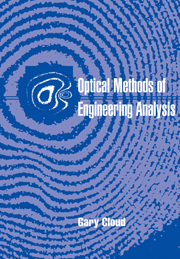Book contents
- Frontmatter
- Contents
- Acknowledgments
- 1 Introduction and orientation
- Part I Optics and interferometry
- Part II Photoelasticity
- Part III Geometrical moire
- 7 Geometrical moire theory
- 8 In-plane motion and strain measurement
- 9 Moire mapping of slope, contour, and displacement
- Part IV Diffraction theory, optical processing, and moire
- Part V Moire interferometry
- Part VI Holographic interferometry
- Part VII Speckle methods
- Author index
- Subject index
7 - Geometrical moire theory
Published online by Cambridge University Press: 12 January 2010
- Frontmatter
- Contents
- Acknowledgments
- 1 Introduction and orientation
- Part I Optics and interferometry
- Part II Photoelasticity
- Part III Geometrical moire
- 7 Geometrical moire theory
- 8 In-plane motion and strain measurement
- 9 Moire mapping of slope, contour, and displacement
- Part IV Diffraction theory, optical processing, and moire
- Part V Moire interferometry
- Part VI Holographic interferometry
- Part VII Speckle methods
- Author index
- Subject index
Summary
This part of the book deals with geometrical moire, an optical effect that is useful, interesting, and, to many minds, esthetically pleasing. It is also the only optical approach discussed here that does not rely on optical wave interference and diffraction. Rather, the geometrical moire fringe patterns are created entirely by mechanical occlusion of light by superimposed gratings. There are other moire techniques, to be examined in Parts IV and V of this text, that do utilize interference and diffraction. The fundamental concepts supporting those more exotic methods are to be found in the basic theory of geometrical moire, to be discussed here.
The moire effect
The moire effect is the mechanical interference of light by superimposed networks of lines. The pattern of broad dark lines that is observed is called a moire (or Moiré) pattern. Such a pattern is formed whenever a repetitive structure, such as a mesh, is overlaid with another such structure. The two structures need not be identical. The effect was evidently noted in ancient times. Modern examples easily observed include the effect when two layers of coarse textile are brought together, the bars observed on television when the scene includes a striped shirt or a building with regular joinings at the proper distance, and the pattern seen through two rows of mesh or picket fence from a distance.
Only a little study of the moire effect uncovers a very striking and useful characteristic: a very large shift in moire pattern is obtained from only a small relative motion between the superimposed networks.
- Type
- Chapter
- Information
- Optical Methods of Engineering Analysis , pp. 147 - 154Publisher: Cambridge University PressPrint publication year: 1995
- 1
- Cited by

